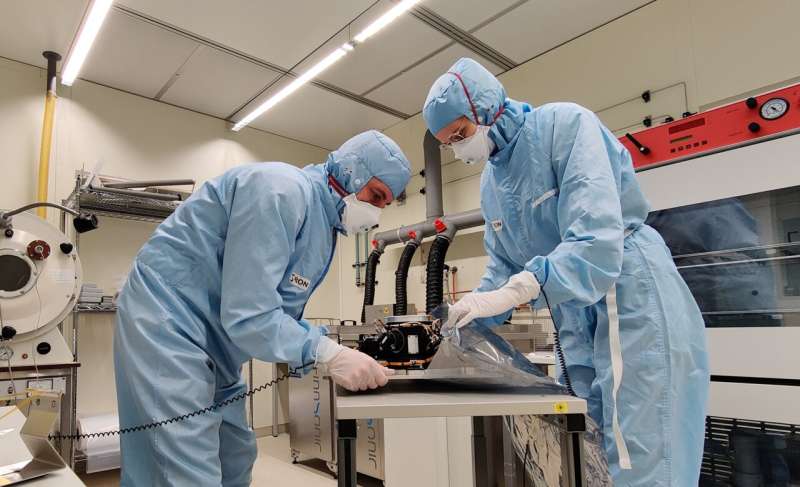SRON engineers wrap up the filter wheel for transport to the Japanese space agency JAXA. Credit: SRON
On June 9, SRON Netherlands Institute for Space Research sends its contributions to the XRISM X-ray telescope to Japan, where space agency JAXA will mount it on the satellite. SRON has been working on a filter wheel plus calibration system for the past few years. In 2023, XRISM will be launched into space, where it will observe phenomena such as black holes and supernovae.
The Earth's atmosphere blocks X-rays from space, much to the relief of people and animals, because it can be harmful to every living species. But because of this protective layer, astronomers miss out on a lot of information about, for example, black holes, the thin matter between clusters of galaxies, supernovae and cosmic particles. Space telescopes offer a solution. In 2023, the Japanese space agency will launch the X-ray satellite XRISM into orbit. Together with the University of Geneva, SRON contributes to XRISM with a filter wheel and the accessory calibration system.
On June 9, SRON sends the filter wheel plus a backup copy to Japan, where all XRISM components will be assembled. In September, an SRON team will fly over to carry out a number of tests on the filter wheel, which will be mounted in the telescope next year. "Everything has been delayed for a year and a half because of corona," says engineer Martin Grim, a member of the team that is traveling to Japan. "We actually wanted to carry out the instrument tests in Japan in May 2020 and XRISM was initially scheduled for launch in 2022."
The filter wheel puts several filters in front of XRISM's X-ray camera, allowing astronomers to filter out the brightness and wavelength of the cosmic rays as desired. For example, they will use the molybdenum neutral-density filter if a star or black hole emits too much X-ray radiation and they will select the beryllium or polyimide aluminum filter to block certain wavelengths. A low-radioactive iron-55 filter is part of the filter wheel to calibrate the camera. Iron-55 continuously emits a known X-ray spectrum serving as a reference point. The calibration system also includes Modulated X-ray Source (MXS) that provide a reference spectrum. The Dutch company Photonis has supplied these MXS units to SRON.
Provided by SRON Netherlands Institute for Space Research
























